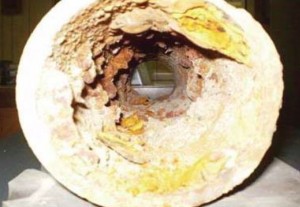8 Things Worth Knowing About Montana’s C- Infrastructure
November 19th, 2014 | By: Infrastructure Report Card
Montana’s Water Pipes Could Stretch From Billings to Miami – Roundtrip Montana has approximately 700 public water systems and over 5,300 miles of water distribution and transmission piping, a longer stretch than driving roundtrip from Billings to Miami. Some Pipes Under Original Montana Plots Might Be Original Too Some of the older and more established communities in Montana have pipes that date back to the late 1800s and early 1900s and much of the pipe has never been replaced. It is not uncommon for the pipelines in originally established areas to have clay tile pipe that has cracked or failed. Montana’s Rough Roads Are Rough On Budgets 46% of major roads in Montana are in poor to mediocre condition and 40% of gravel roads are in poor or failed condition. These rough roads cost each Montanan approximately $292 to $484 per year in extra maintenance costs depending on their area’s roads. Montana School Buildings Need Some T.L.C. A bottom-to-top statewide school facilities review revealed that 66% of schools showed signs of damage and wear, as well as environmental needs such as HVAC, roof, and electrical issues. Old Dams Don’t Necessarily Have to Be Inspected The overall condition of Montana’s dams is difficult to track because 75% do not have periodic engineering inspections and are not required to have operation permits. Transit Funding Recently Spiked Several agencies benefited from over $15 million in Federal recovery investments in 2009, which essentially doubled short-term transit funding in the state. Montana’s Trash Ends Up In Less Places Since 1993, significant improvements have occurred within Montana’s solid waste infrastructure and operations, including a reduction from over 300 facilities statewide to just 31. Replacing Montana’s Water and Wastewater Infrastructure Could Cost More than 500 Bobcat Stadiums Current estimates to completely replace Montana’s entire water and wastewater infrastructure are estimated to range between $12 billion and $15 billion, or in other terms, more than 500 Montana State University’s Bobcat Stadiums. Find out more about the inaugural Report Card for Montana’s Infrastructure!Tags: dams, infrastructure, Montana, pipes, report card, schools, water
No Comments »
Election Results Signify Shift in Americans' Willingness to Invest in Infrastructure
November 7th, 2014 | By: Olivia Wolfertz
In light of the recent elections, infrastructure investment has now moved from a topic of discussion into a plan for action in many states. With the nation’s pressing infrastructure needs and limited federal funds available, ASCE is pleased that many states are finding creative ways to pay for infrastructure improvements through other means. With six states successfully passing ballots to fund infrastructure, it’s clear that many Americans are tired of underinvestment and want to see initiatives to improve infrastructure in their communities. In Maryland and Wisconsin, voters approved a transportation “lockbox” to secure funds for infrastructure needs. In Texas, oil and gas taxes will be used as a source for transportation funding. Rhode Island passed an initiative allowing the sale of bonds to fund renovations to mass transit and California passed an initiative that will improve water security for the state. Even in Michigan, where there was no infrastructure-related ballot initiative, Governor Rick Snyder announced his plan to raise at least $1 billion in new revenues for road repairs through fuel taxes and fees before the end of the year. Joseph Kane, a researcher with the Metropolitan Policy Program said, “The public sees the impact of transportation on their lives every day and so the attention this issue is receiving at the ballot box shows their growing awareness of problems.” Though several states are making proactive strides to improve infrastructure through investment, not all states are willing to take these steps. Massachusetts voters repealed gas tax indexing, which would have provided critical funding for transportation in the state. Louisiana also rejected a ballot initiative which would have created an infrastructure bank. ASCE President, Bob Stevens, Ph.D., P.E., said, “By failing to increase revenue or protect funding, these states are continuing with the status-quo, which is unacceptable. Leaders at all levels of government are now tasked with finding solutions to the infrastructure deficit.” Ballot measures to improve state infrastructure are steps in the right direction but are not enough without long-term, sustainable funding at the federal level. Voters demonstrated they want more investment in infrastructure. Now it’s time for Congress to respond to that plea and #FixtheTrustFund.Tags: 2014BallotInitiatives, infrastructure, transportation, water
No Comments »
Big Wins for Infrastructure on Election Day
November 5th, 2014 | By: Maria Matthews
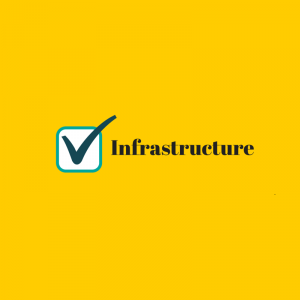 Leading up to yesterday’s election ASCE brought you information on many statewide ballot measures. ASCE staff worked with our dedicated members on the ground in California, Hawaii, Louisiana, Maryland, Massachusetts, Rhode Island, Texas, and Wisconsin. The issues being put to the test ranged from roads to water and addressed improvements to aging structures, compliance with safety ordinances, or preventing the diversion of dedicated revenue.
Now that ballots have been counted, infrastructure has emerged victorious in six of eight states. California, Hawaii, Maryland, Rhode Island, Texas, and Wisconsin, all overwhelmingly voted to take steps forward in addressing their state’s needs.
A win for infrastructure is a win for the residents and businesses in the state. Whether it’s improvements to the water system, mass transit investment or designating dedicated road funding, everyone benefits from well-maintained infrastructure.
Maryland and Wisconsin voters have successfully prevented their Trust Funds from being raided for general use while Texas established an infrastructure funding that will draw from oil and gas taxes as well as borrow from “rainy day” coffers. Commuting should soon be a bit easier in Rhode Island as a significant investment in mass transit will now be made with the hopes of alleviating congestion and improving accessibility. Investing in improvements to transportation and transit infrastructure benefits both individuals and businesses as it makes travelling safer, moving goods easier, and extends the utility of existing infrastructure.
Hawaii Dam and Reservoir owners will benefit from the ability to request financial assistance as they maintain and repair structures to ensure compliance with Hawaii’s safety standards. Californians can now be better prepared for the extreme drought conditions they’re currently experiencing by investing in projects that will improve water storage and reclamation, and also improve quality and access to clean water in certain parts of the state.
In other states, increasing the investment in infrastructure was unsuccessful. Voters in Louisiana and Massachusetts chose to continue with the status quo; the lack of serious investment in aging infrastructure could end up costing the state and its residents more in the long run. Poor road conditions, like those that exist in Louisiana, are not only costly to repair but, are also burdensome to commuters as it wears on their car. A little bit of investment now could mean a significant amount of savings in the long run. Massachusetts voters opted not to ensure a steady revenue stream for the maintenance of and improvement to state bridges and roads by repealing their gas tax’s link to the consumer price index.
Pass or fail, we hope that Tuesday’s results will bring renewed interest during the 2015 state legislative session in building and maintaining infrastructure systems that reflect the growing needs of residents and its economy. Ideally this momentum will also carry through to our nation’s capital and lead Congress to #FixtheTrustFund and address other sectors of our infrastructure in critical need of attention. Join us on Thursday, November 13, 2014 for a free eLearning Webinar What Civil Engineers Need to Know About 2014 Elections, which will further dive into this topic.
Leading up to yesterday’s election ASCE brought you information on many statewide ballot measures. ASCE staff worked with our dedicated members on the ground in California, Hawaii, Louisiana, Maryland, Massachusetts, Rhode Island, Texas, and Wisconsin. The issues being put to the test ranged from roads to water and addressed improvements to aging structures, compliance with safety ordinances, or preventing the diversion of dedicated revenue.
Now that ballots have been counted, infrastructure has emerged victorious in six of eight states. California, Hawaii, Maryland, Rhode Island, Texas, and Wisconsin, all overwhelmingly voted to take steps forward in addressing their state’s needs.
A win for infrastructure is a win for the residents and businesses in the state. Whether it’s improvements to the water system, mass transit investment or designating dedicated road funding, everyone benefits from well-maintained infrastructure.
Maryland and Wisconsin voters have successfully prevented their Trust Funds from being raided for general use while Texas established an infrastructure funding that will draw from oil and gas taxes as well as borrow from “rainy day” coffers. Commuting should soon be a bit easier in Rhode Island as a significant investment in mass transit will now be made with the hopes of alleviating congestion and improving accessibility. Investing in improvements to transportation and transit infrastructure benefits both individuals and businesses as it makes travelling safer, moving goods easier, and extends the utility of existing infrastructure.
Hawaii Dam and Reservoir owners will benefit from the ability to request financial assistance as they maintain and repair structures to ensure compliance with Hawaii’s safety standards. Californians can now be better prepared for the extreme drought conditions they’re currently experiencing by investing in projects that will improve water storage and reclamation, and also improve quality and access to clean water in certain parts of the state.
In other states, increasing the investment in infrastructure was unsuccessful. Voters in Louisiana and Massachusetts chose to continue with the status quo; the lack of serious investment in aging infrastructure could end up costing the state and its residents more in the long run. Poor road conditions, like those that exist in Louisiana, are not only costly to repair but, are also burdensome to commuters as it wears on their car. A little bit of investment now could mean a significant amount of savings in the long run. Massachusetts voters opted not to ensure a steady revenue stream for the maintenance of and improvement to state bridges and roads by repealing their gas tax’s link to the consumer price index.
Pass or fail, we hope that Tuesday’s results will bring renewed interest during the 2015 state legislative session in building and maintaining infrastructure systems that reflect the growing needs of residents and its economy. Ideally this momentum will also carry through to our nation’s capital and lead Congress to #FixtheTrustFund and address other sectors of our infrastructure in critical need of attention. Join us on Thursday, November 13, 2014 for a free eLearning Webinar What Civil Engineers Need to Know About 2014 Elections, which will further dive into this topic.
Tags: 2014BallotInitiatives, infrastructure, transportation, water
No Comments »
This Week in Infrastructure: Getting Infrastructure Projects Moving Through the Ballot Box
November 1st, 2014 | By: Olivia Wolfertz
With Election Day around the corner, ballot initiatives related to infrastructure will give voters a chance to help shape our nation’s future. The economic, environmental and public safety issues on each state’s ballots underscore ASCE’s strategic initiative: improving our nation’s infrastructure. Infrastructure is the backbone of our economy. The roads and bridges we drive on, the water we drink, the schools we attend and the power systems we rely on are aging badly and in need of repair. ASCE’s 2013 Report Card shows that our nation’s backbone—infrastructure—is in serious need of investment to bring it into good condition. In The Huffington Post blog, Executive Director of the BlueGreen Alliance wrote, “Without a world-class infrastructure, we will not be able to compete in the global marketplace. Resilient infrastructure systems mean we can keep our communities healthy and safe. And, fixing and modernizing these systems is an economic opportunity we cannot afford to pass up.” As this blog illustrates, clearly more advocacy groups realize the domino effect that failing infrastructure has on our nation’s economy and the welfare of all Americans. Without infrastructure in a state of good repair, our nation’s most essential resources are at serious risk. NPR recently exposed how much water is currently being wasted as a result of aging infrastructure. According to NPR, researchers have estimated aging pipes, broken water mains and faulty meters have resulted in enough wasted drinking water to rise 300 feet above Manhattan. And the American Water Works Association added, “nationwide, the amount of water that is lost each year is estimated to top 2 trillion gallons.” According to the Center for Neighborhood Technology (CNT), every year we lose enough water due to aging infrastructure to, “swallow several major American cities whole.” These are startling statistics that cannot be ignored. In light of increased media focus on the state of our nation’s infrastructure and the consequences of continuing to delay much-needed investment, political leaders are speaking out for solutions. In Vice President Joe Biden’s recent speech for increased infrastructure spending, he said that Americans need to, “Build, build, build….we always have to build. That’s who we are.” Biden noted that such building would pay off with jobs and growth in manufacturing. When it comes to our nation’s infrastructure, there is more at stake than detoured commutes and increased traffic. Infrastructure is a vital part of our everyday lives and is the foundation that drives our economy. Election season is a time to not only reflect on its importance but also to make your voices heard at the ballot box to change it for the better.Tags: 2013 Report Card, infrastructure, water, water infrastructure
No Comments »
Infrastructure in Arkansas Earns D+
October 17th, 2014 | By: Infrastructure Report Card
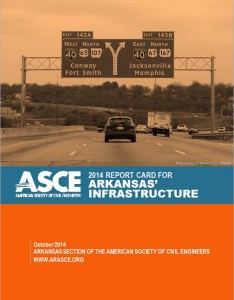 This Thursday, the Arkansas Section of the American Society of Civil Engineers released their inaugural Infrastructure Report Card for the state grading the states’ infrastructure.
Arkansas’ infrastructure received a cumulative GPA of “D+” in the 2014 Report Card for Arkansas’ Infrastructure. The seven infrastructure categories evaluated in the report include:
Roads (D+)
Drinking water (D+)
Transit (D+)
Levees (D)
Dams (D)
Bridges (C+)
Wastewater (C+)
The report noted that Arkansas has the 12th largest highway system in the nation, as well as the second highest traffic fatality rate in the country as of 2010. In addition, the state has 214 wastewater treatment facilities that will need upgrades and improvements in the next 20 years.
The Report Card, the first for Arkansas, was released during the annual ASCE Arkansas Section Conference and included a keynote address by Scott Bennett, director of the Arkansas State Highway and Transportation Department. The report was featured in both the Arkansas Democrat-Gazette and the Times-Record. The effort was led by Aaron Robinson, P.E., based in Jacksonville, Arkansas.
Read the full Arkansas Report Card
This Thursday, the Arkansas Section of the American Society of Civil Engineers released their inaugural Infrastructure Report Card for the state grading the states’ infrastructure.
Arkansas’ infrastructure received a cumulative GPA of “D+” in the 2014 Report Card for Arkansas’ Infrastructure. The seven infrastructure categories evaluated in the report include:
Roads (D+)
Drinking water (D+)
Transit (D+)
Levees (D)
Dams (D)
Bridges (C+)
Wastewater (C+)
The report noted that Arkansas has the 12th largest highway system in the nation, as well as the second highest traffic fatality rate in the country as of 2010. In addition, the state has 214 wastewater treatment facilities that will need upgrades and improvements in the next 20 years.
The Report Card, the first for Arkansas, was released during the annual ASCE Arkansas Section Conference and included a keynote address by Scott Bennett, director of the Arkansas State Highway and Transportation Department. The report was featured in both the Arkansas Democrat-Gazette and the Times-Record. The effort was led by Aaron Robinson, P.E., based in Jacksonville, Arkansas.
Read the full Arkansas Report Card
Tags: Arkansas, bridges, dams, infrastructure, levees, report, report card, roads, transit, wastewater, water
No Comments »
Vermont Infrastructure Shows Improvement in New Report Card
October 17th, 2014 | By: Infrastructure Report Card
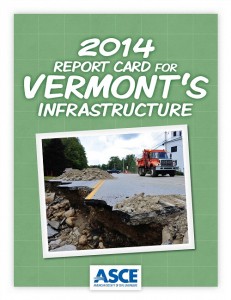 The latest Report Card for Vermont’s Infrastructure showed a slight improvement in their overall GPA to a “C.” The 2014 Report Card for Vermont’s Infrastructure is an update from 2011, when the state received a “C-” cumulative grade. The Report Card assessed bridges (C), dams (C), drinking water (C-), wastewater (D), roads (C-), and solid waste (C+).
After Tropical Storm Irene damaged the state’s infrastructure backbone in 2011, Vermont made significant investments through catch-up and emergency funding. In addition, the state’s most recent transportation funding package provided close to $700 million for transportation infrastructure, the largest transportation infrastructure investment in state history. There have also been programmatic changes. Road fatalities have been cut nearly in half since 2006 due to changes made using the Strategic Highway Safety Plan.
Led by Amanda Hanaway-Corrente, P.E. who chaired the effort and Vermont Section President-Elect Jessica Clark Louisos, P.E., the Report Card was released at a luncheon in Montpelier, which included a keynote from Sue Minter, deputy secretary at the Vermont Agency of Transportation (VTRANS) and David Mears, commissioner of the Department of Environmental Conservation.
“Vermont is poised to grow our economy as we continue to make investments into our infrastructure. The transportation funding that was signed into law in June is one example of how the state continues to focus on innovation and jobs,” said Minter.
Media coverage of the event included the Burlington Free Press and WCAX.
Read the full Vermont Report Card
The latest Report Card for Vermont’s Infrastructure showed a slight improvement in their overall GPA to a “C.” The 2014 Report Card for Vermont’s Infrastructure is an update from 2011, when the state received a “C-” cumulative grade. The Report Card assessed bridges (C), dams (C), drinking water (C-), wastewater (D), roads (C-), and solid waste (C+).
After Tropical Storm Irene damaged the state’s infrastructure backbone in 2011, Vermont made significant investments through catch-up and emergency funding. In addition, the state’s most recent transportation funding package provided close to $700 million for transportation infrastructure, the largest transportation infrastructure investment in state history. There have also been programmatic changes. Road fatalities have been cut nearly in half since 2006 due to changes made using the Strategic Highway Safety Plan.
Led by Amanda Hanaway-Corrente, P.E. who chaired the effort and Vermont Section President-Elect Jessica Clark Louisos, P.E., the Report Card was released at a luncheon in Montpelier, which included a keynote from Sue Minter, deputy secretary at the Vermont Agency of Transportation (VTRANS) and David Mears, commissioner of the Department of Environmental Conservation.
“Vermont is poised to grow our economy as we continue to make investments into our infrastructure. The transportation funding that was signed into law in June is one example of how the state continues to focus on innovation and jobs,” said Minter.
Media coverage of the event included the Burlington Free Press and WCAX.
Read the full Vermont Report Card
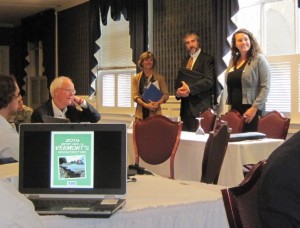
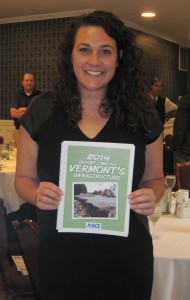
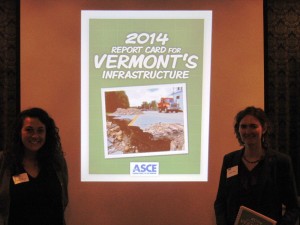
Tags: bridges, dams, grade, infrastructure, report card, roads, transportation, Vermont, wastewater, water
No Comments »
California Proposition 1 Invests in Water Infrastructure
October 13th, 2014 | By: Maria Matthews
Proposition 1 is a statewide ballot measure that will provide a dedicated source of funding to California’s water supply infrastructure. This includes much needed public water system improvements, surface and groundwater storage, drinking water protection, recycling and advanced water treatment technology among other eligible projects. California is the midst of a severe, multi-year drought and has an aging water infrastructure system. This ballot measure is a fiscally responsible step toward meeting the state’s overall water needs. It secures California’s water future by keeping family farms and businesses productive, stimulates the economy through the construction of new facilities needed to store, deliver, and treat water. A “yes” vote will ensure a reliable source of funding and prioritize investment in state water infrastructure projects. ASCE recognizes that America’s drinking water, stormwater, and wastewater systems are aging or failing and must be upgraded or expanded to meet increasing federal and state environmental requirements. These requirements have created a crisis that is beyond the means of local communities to solve and for which federal assistance is clearly justified. Not meeting the investment needs of the next 20 years risks reversing the environmental, public health, and economic gains of the last three decades. A “yes” vote will ensure funding for key public benefits: water quality, flood control and the preservation of natural habitat. When you talk with a neighbor about the election, remember this: ✓ Provides safe drinking water for all communities. ✓ Expands water storage capacity as a means of managing and preparing for drought. ✓ Invests in water conservation, recycling and improved local water supplies. ✓ Increases flood protection. ✓ Secure and safeguard California’s water supply without raising taxes. The measure is currently supported by ASCE Region 9 and a number of professional societies, members of the business community, conservation groups, and leading state politicians. Support a comprehensive state water plan by voting “yes” on Proposition 1 in November.Tags: 2014BallotInitiatives, water, water infrastructure
No Comments »
Join the #WaterWorks Thunderclap to Show Your Support for Water Infrastructure Investment
September 3rd, 2014 | By: Becky Moylan
Without clean, safe, and reliable water and wastewater systems, one-fifth of our US economy would grind to a halt. Yet, in the 2013 Report Card for America’s Infrastructure, drinking water and wastewater both received D grades.
On Wednesday, Sept. 10, ASCE will join other water leaders as part of the Value of Water Coalition to share the importance of water with White House and Congressional leaders. If you’re not here in DC, you can still show your support and let Congress know that water should be their priority. Consider joining our Thunderclap on social media – you just need to sign up by next Monday. Thunderclap is a tool that lets a message be heard when we all say it together. When you join the #WaterWorks Thunderclap, you and fellow supporters will share the exact same message at the exact same time, spreading an idea across Facebook, Twitter, and Tumblr that cannot be ignored. The goal is to trend in social media. By joining, you’re allowing Thunderclap to share a single message on your behalf. This is only the case when you click the red button on the campaign page to support with Twitter, Facebook, or Tumblr. After the campaign is complete, Thunderclap won’t post any additional messages. Visit here to help the Value of Water Coalition meet its goal and spread the message through Thunderclap on Facebook, Twitter, and Tumblr. The message in the blue box is what will appear on your own social media pages. Just click the red boxes to share the message. It will automatically go out on September 9, 2014 at 12:00pm EST.Tags: Drinking Water, thunderclap, wastewater, water, Water Resources, Water Works
5 Comments »
ASCE Members Advise Federal Government on Water Information Programs
September 2nd, 2014 | By: Whitford Remer
ASCE members Martha Juch, P.E., D.WRE, and Robert Schreiber, P.E., BCEE, D.WRE participated in the Advisory Committee on Water Information (ACWI) annual meeting last month in Reston, Virginia. The advisory committee’s mission is to improve water information for decision making for natural resources management and environmental protection. The U.S. Geological Survey (USGS) is the primary federal agency charged with overseeing the committee. Anne Castle, Assistant Secretary for Water and Science at USGS, challenged the committee last week to begin focusing on building out a new project called the Open Water Data Initiative (OWDI). The initiative seeks to compile water metadata into to a central database that is open to the public. Currently, water data is collected using various standards and is often stored on a specific project website, in a state database or withheld by a single agency. The hope is OWDI will standardize the collection practice and make the data open and easy to access through the central database. The OWDI is one of several open data initiatives currently being pursued by the Administration. In May 2013, President Obama signed Executive Order 13642 “Making Open and Machine Readable the New Default for Government Information” to increase public accessibility to scientific data collected by the federal government. OWDI is modeled after the Open Climate Initiative. ASCE will continue to support important open government initiatives, particularly those that increase the public’s ability to access scientific data.Tags: science, USGS, water, Water Resources
No Comments »
Harnessing the Natural Process for Clean Water in Colorado
August 20th, 2014 | By: Infrastructure Report Card
 Let’s Envision the Infrastructure for Tomorrow
America’s infrastructure needs a national commitment to bring existing infrastructure into a state-of-good-repair, and in the long term we must modernize and build in a targeted and strategic manner. This means leadership at the federal, state, and local levels of government, by businesses and individuals, to communicate the importance of our nation’s infrastructure, to craft innovative solutions that reflect the diverse needs of the nation, and to make the investments the system needs. By employing strategies to use every dollar more efficiently and by deploying creative solutions to infrastructure development such as public–private partnerships, we can implement the right projects on time at the right price. Below is a brief success story that shows how we can do this effectively.
Water Success Story: Harnessing the Natural Process for Clean Water
Let’s Envision the Infrastructure for Tomorrow
America’s infrastructure needs a national commitment to bring existing infrastructure into a state-of-good-repair, and in the long term we must modernize and build in a targeted and strategic manner. This means leadership at the federal, state, and local levels of government, by businesses and individuals, to communicate the importance of our nation’s infrastructure, to craft innovative solutions that reflect the diverse needs of the nation, and to make the investments the system needs. By employing strategies to use every dollar more efficiently and by deploying creative solutions to infrastructure development such as public–private partnerships, we can implement the right projects on time at the right price. Below is a brief success story that shows how we can do this effectively.
Water Success Story: Harnessing the Natural Process for Clean Water
Tags: Colorado, drought, energy, infrastructure, Prairie Waters Projec, purification, water
No Comments »



 */ ?>
*/ ?>




